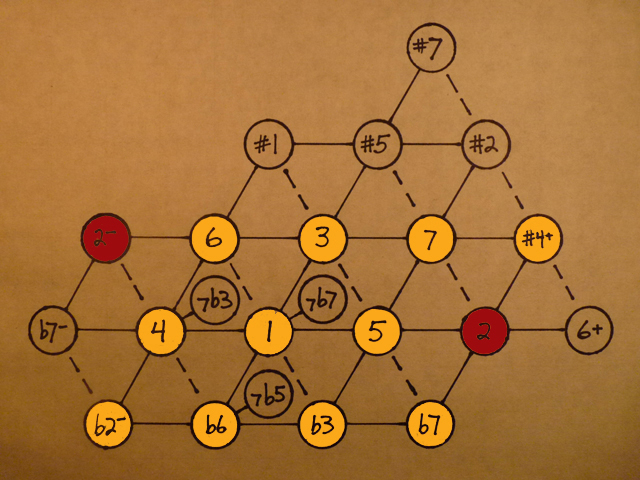Another Major Second: The 10/9
When I started exploring the extended lattice beyond the central 12 notes, the first note that was really new to me was the 10/9 major second, also called the minor or lesser whole tone. Now I call it the 2-.
 The lattice extends forever in all directions. When you continue multiplying and dividing, generating new notes beyond the boundaries of the central zone, the notes start to repeat, but not quite. The notes in red, the 2 and the 2-, are very close in pitch. They are different flavors, if you will, of the interval of a major second, or whole tone — a distance of two half steps, two keys on the piano.
The lattice extends forever in all directions. When you continue multiplying and dividing, generating new notes beyond the boundaries of the central zone, the notes start to repeat, but not quite. The notes in red, the 2 and the 2-, are very close in pitch. They are different flavors, if you will, of the interval of a major second, or whole tone — a distance of two half steps, two keys on the piano.
Even though they are so close in pitch (204 cents for the 2, 182 cents for the 2-, only 22 cents apart), the two major seconds are generated in different ways and have very different functions and characters.
The 2 is an entirely overtonal note, that is, generated by multiplying alone. Such notes can be found in the chord of nature, the harmonics of a vibrating string. The character of notes is somewhat subjective, but for me, overtonal notes have a stable, sort of upbeat or positive character, and even though the 2 is somewhat dissonant, it has a kind of peaceful sound, that shows up well in ninth chords. Its recipe is x3, x3, or x9, octave reduced to 9/8.
The 2- is a combination of reciprocal and overtonal energy. It’s farther from the center than the 2, and more dissonant. Its recipe is /3, /3, x5, or 5/9, which octave reduces (or expands, really) to 10/9. It is darker, bluesier perhaps, and functions differently in chord progressions.
These very similar ratios, 10/9 and 9/8, 182 and 204 cents, are in fact entirely different beasts. Equal temperament has obscured this difference over the years. In ET, both notes are played at the compromise pitch of 200 cents, but that does not change the functional difference. It is extremely useful when writing or arranging to know whether you are playing a 2 or a 2-.
I tried making a demo of how they sound, as with other notes, but I think that played by themselves, out of context, the 2 and 2- are hard to tell apart. To get the difference, I think you have to sing them against a drone (scroll down the linked page a bit and there’s a list of Indian drones to play around with, it’s really fun to improvise melodies over these) and feel them in your own body. Mathieu shows you how to sing the 10/9 note in Harmonic Experience.
The functional differences really show up when you’re designing chord progressions that make sense. A chord progression is a journey on the lattice, and if you’re roaming in western territory, that is, to the left of the center, you want to use the 2- in your chords and melodies, and if you’re in overtonal, eastern lands, to the right of center, the 2 is going to sound better. It’s a crucial distinction in just intonation. Not so much in ET, since the notes are tuned the same — but awareness of where you are on the lattice really helps when you’re writing ET chord progressions.
It’s an old puzzle. Why do some progressions feel “right,” and others “wrong”? Knowing the map of harmony, the lattice, helps a lot. Much more to come in later posts.
Next: Commas